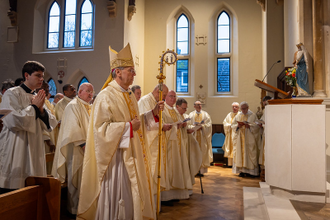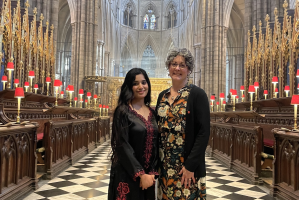Gospel in Art: Saint Ignatius of Antioch, Bishop & Martyr

Ignatius of Antioch, 17thC Russian Icon © Pushkin Museum, Moscow
Source: Christian Art
Gospel of 17 October 2024
Luke 11:47-54
Jesus said: 'Alas for you who build the tombs of the prophets, the men your ancestors killed! In this way you both witness what your ancestors did and approve it; they did the killing, you do the building.
'And that is why the Wisdom of God said, "I will send them prophets and apostles; some they will slaughter and persecute, so that this generation will have to answer for every prophet's blood that has been shed since the foundation of the world, from the blood of Abel to the blood of Zechariah, who was murdered between the altar and the sanctuary.
'Yes, I tell you, this generation will have to answer for it all.'
'Alas for you lawyers who have taken away the key of knowledge! You have not gone in yourselves, and have prevented others going in who wanted to.'
When he left the house, the scribes and the Pharisees began a furious attack on him and tried to force answers from him on innumerable questions, setting traps to catch him out in something he might say.
Reflection on the Russian Icon
Today, we celebrate Saint Ignatius of Antioch, early Church Father, Bishop, and martyr. Born in Syria in the mid-1st century, Ignatius is traditionally believed to have been personally taught by the Apostle John, alongside another future martyr, Saint Polycarp. Around the year 70, Ignatius became the Bishop of Antioch, assuming leadership of a Christian community said to have been first led by Saint Peter before his move to Rome. Antioch, located in modern-day Turkey, was one of the key cities of the Roman Empire and the place where the followers of Jesus were first called 'Christians'.
Ignatius' letters reveal his deep passion for Church unity, his warnings against heresy, and his profound devotion to the Eucharist, which he called the "medicine of immortality." A beautiful quote. He is also credited with the earliest surviving use of the term "Catholic" to describe the Church, emphasising its universality and completeness.
As he faced martyrdom, Ignatius wrote these powerful words: "Now I begin to be a disciple. Let fire and the cross; let the crowds of wild beasts; let tearings, breakings, and dislocations of bones; let cutting off of members; let shatterings of the whole body; and let all the dreadful torments of the devil come upon me: only let me attain to Jesus Christ."
Saint Ignatius bore his final witness to Christ in the Flavian Amphitheatre in Rome, where he was mauled to death by lions. This dramatic moment is captured in our 17th century Russian icon, kept at the Pushkin Museum, Moscow. Two lions are devouring the saint, whilst God the Father is stretching out his hand in the top left corner. Salvation for the saint is near. Ignatius is staring straight at the lion; staring in the face of evil and death, his resolve is strong.
LINKS
Gospel in Art: https://christian.art/
Today's Reflection: https://christian.art/daily-gospel-reading/luke-11-47-54-2024/


















